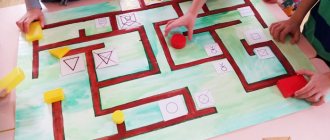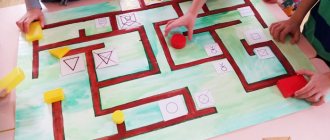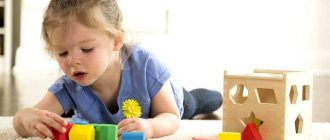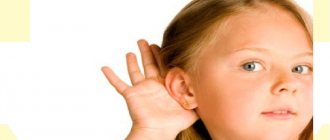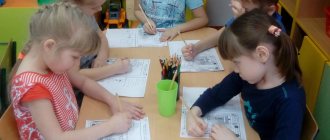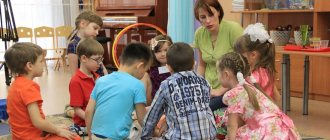Formation of memory as a basic mental function
The cognitive development of a child is unthinkable without the active use of memory. This mental process allows you to accumulate, store and recall the necessary information. The memory of a preschooler expands its capabilities every year.
In the first years of life, memory is formed as a component function of perception. The most striking characteristics of those objects that are perceived by a child are involuntarily recorded by brain cells. Information is accumulated about surrounding people, about various objects, about their properties, about repeated actions. At the age of three years, memory already acts as an independent cognitive function.
The simplest form of recollection is manifested in the baby's recognition of objects that he has already seen, heard or touched before. In preschool age, the functional capabilities of receiving and retrieving information are actively developing, which ensures more complex memory work. A preschooler uses all memory functions:
- memorization
- preservation
- recollection
- recognition
- playback
Memorization is carried out by “linking” new material to already familiar material. For a preschooler, such consolidation occurs fleetingly. Children do not yet know how to use special memorization techniques.
Retention is a mental process that ensures that information is retained for a certain time. It can be both short-term and long-term. Young children can remember for a long time what caused special emotions. Fear may linger for a long time, but the baby can also retain impressions of joyful events.
Recall is the process of retrieving previously remembered information. The request on the way home: “Mom, buy me a doll like Olya’s” is nothing more than a recollection of one’s own admiration for Olya’s treasure.
Recognition is an easier way to remember familiar information because it relies on a newly seen, heard, or felt stimulus.
Reproduction is a complex process of retrieving already stored material. The limited life experience of a preschooler also imposes restrictions on the reproduction of information. The child remembers under the influence of similar impressions.
The main feature of a preschooler's memory is the predominance of involuntary memorization. Playback works the same way.
Classification
Memory is divided into many types, depending on a number of conventions. Each of them requires separate development and a special approach, because There are no universal methods suitable for all species. Memory is classified according to the conditions of memorization, the duration of storage of information and the method of perception.
Memorization conditions mean whether a person specifically remembered the information. There are 2 types:
- Free The brain remembers information that a person wanted to store in his head.
- Involuntary. Mechanical memorization of everything that was perceived by the brain.
Based on the duration of information storage, there are 2 types:
- Short-term. The brain easily retains information, but soon forgets it completely.
- Long-term. It may take more effort to remember, but the information will be stored in your head for a long time.
Methods of perceiving information force us to distinguish 4 more types of memory:
- Figurative. Remembering everything a person saw.
- Verbal-logical. Save sentences you hear or read.
- Motor. Ability to quickly memorize physical movements.
- Emotional. Memories of all events that caused strong emotions and feelings.
Special methods aimed at developing memory in children can improve any of the listed types of memorization of information. Some methods can affect several types of memory at once, as well as the quality of concentration and logic.
Figurative memory is basic for most children. It is divided into visual, auditory, olfactory, tactile, and gustatory.
What types of memory predominate in preschool age?
Activation of a preschooler's memory occurs through perception. Information reaches the child through visual, auditory, taste, and tactile receptors. The received signals form a certain image that the child remembers. For this reason, due to nature, the predominant type of memory in preschoolers is figurative.
The following types of memory develop intensively in preschool children:
- figurative
- verbal
- motor
Figurative memory helps the child master new concepts and expand his vocabulary.
Having heard that a zebra is a “striped horse,” the child vividly forms the image of the animal. The new information for him is the word “zebra” itself.
Perhaps the child’s imagination drew a not quite similar image. In reality, it will correct itself. In the meantime, the new word will already be firmly established in the preschooler’s vocabulary. The formation of verbal-logical memory occurs.
Thus, the development of memory in ontogenesis goes from the predominance of figurative to the use of verbal forms. We can say that speech takes a preschooler’s memory to a higher level and increases its productivity.
Motor memory in preschool age is oriented towards a given pattern. These are no longer the simplest movements (assembling a pyramid, threading a button through a loop) that are mastered at an early age. A preschooler, looking at an adult, learns dance movements. Masters such complex household operations as tying shoelaces and sewing on buttons.
Memory of children of primary preschool age
In early preschool age, images are formed on the basis of practical actions. A 3-4 year old child learns about the world through actions and remembers the most important things for himself.
Information is stored fragmentary, in the form of figurative single representations. So, a child may be afraid of Santa Claus, and no explanation that dad dressed up in this costume for the next holiday will help.
At this age, the most emotional events, bright objects, and frequently repeated actions are remembered.
The separation of features and their generalization during comprehension and memorization is formed due to the development of speech. When a preschooler masters more concepts and uses words, his perception becomes more stable. This, in turn, helps the child associate the content with a specific word and remember it as an image. But in younger preschoolers, such linking occurs involuntarily.
Features of memory in older preschool age
The older a preschooler gets, the stronger the connection between memory and thinking becomes. The child masters his native language, learns to analyze, compare and generalize. As a result, images are remembered through mental operations.
The older preschooler himself makes up descriptive definitions in order to remember the new concept. “An escalator is also a staircase, only it moves,” “The blackberry is called that because it is covered in thorns, like a hedgehog.”
But in older preschool age, in order to remember and remember, support in the form of an image is not always needed. Poems are remembered for their rhythm and rhymes, as the sound culture of speech develops. When retelling a fairy tale or story he has heard, the preschooler relies on a logical sequence of events. Although he can equally imagine himself in the role of one of the characters, which promotes memorization.
The peculiarities of memorization and reproduction in older preschool age also manifest themselves in the fact that they gradually acquire an arbitrary character.
Methods
First, you need to get to know exactly what methods of memory development children have and which of them can be successfully implemented at home. It would also be a good idea to find out in kindergarten and school what they use there, so that there are no contradictions in pedagogical systems.
Games
Since the leading activity in childhood is play (especially in preschool children and in primary school), this method of memory development is considered one of the most effective. The choice is quite large. The main thing is to fit into the age range.
For the development of visual memory
- "Let's go to the exhibition"
An illustration, a picture, a reproduction of an artistic canvas (depending on age) is given for study for 30-60 seconds. The task is to describe it in detail.
- "Auction"
Several toys are displayed and removed after a minute. Whoever describes the items they like the most and in more detail wins.
For the development of auditory memory
- "Telling a fairy tale"
In a group of 5-7 people, each person takes turns composing 2-3 sentences; all subsequent storytellers should not be confused about the characters and should continue the storyline to make a fairy tale.
- "Shop"
Talk out the shopping list (the number varies depending on age) so that the child remembers it.
These games will help develop memory in preschoolers and primary school children. Teenagers need to be offered something different. In particular, tabletop (chess, checkers, lotto) and computer (strategy, action).
For more memory development games, see the link.
Exercises
Special exercises help train your memory well. They are already deprived of a playful form and prepare children for the fact that this process often requires effort and perseverance. In adolescence, this method becomes the leading one.
- "Remember the words"
An adult says aloud several unrelated words. The task is to repeat them in the same sequence immediately, after half an hour and after 2-3 hours.
- "Sea of Sounds"
A melody or any sound is turned on. We need to guess a song, a piece of music, or who pronounces such sounds and where we can hear them.
- "Pig in a poke"
Having put your hands into a closed and tight bag, you need to feel the objects lying there and name what they are.
- "Young Artist"
The adult names the words, the child draws them. At the same time, it is not necessary to depict every detail and strive for proportions and aesthetic artistry. The task is to name these words in an hour, using your own illustrations.
Exercises that develop memory are good because they can be used at literally any age by choosing the right tasks. After 12 years of age, a child can perform them independently, without adult supervision.
Techniques for different ages are in the article earlier.
Neurobics
Neurobics - gymnastics for the brain. Modern developing technology at the peak of popularity. Programs adapted for children have already appeared.
- Mental arithmetic, without a calculator.
- Solving puzzles, crosswords, riddles.
- Go with your child to kindergarten, school, store, or just for a walk on different routes. Let him remember the characteristics of each.
- Starting at the age of 10, ask him once a week to perform familiar actions with the other hand: brushing teeth, holding a spoon, writing.
- Ask your child a basic question and ask him to answer in different ways.
Example of the last task.
Question: what kind of apple is this?
Possible answers:
- “Delicious” (green, big and its other characteristics using adjectives).
- “I need to try it to answer this question.”
- “It was bought in a store” / “It was recently picked from the garden”, etc.
Neurobics develops thinking, brain activity and intellectual abilities, and at the same time trains memory. The volume of memorized information becomes larger.
Finger gymnastics
Finger gymnastics synchronizes the work of the right and left hemispheres, and also helps to develop the child’s speech abilities at an early age. Experts say that it must be included in memory training classes from 3 to 10 years and even older. There are a huge number of complexes in verse that will be interesting to all children:
- White-sided magpie;
- Bunny;
- Lock;
- Ship;
- Berries;
- Maple;
- Fish and many others.
Example of the “Lock” exercise:
All poems for finger gymnastics exercises are read by adults clearly, rhythmically, but slowly. For the first time, you can do everything together, and then ask the child to repeat the movements to the words of an adult independently.
Speech exercise
To develop a child’s memory, you definitely need to speak tongue twisters with him. With age they should become more complex and longer. They activate the speech areas of the brain and strengthen neural connections.
- For preschoolers
Ivashka has a shirt, the shirt has pockets, Pockets have a shirt, Ivashka has a shirt.
- For elementary school
Grass in the yard, firewood on the grass. Don't cut wood on the grass in your yard.
- For teenagers
The cap is not sewn according to Kolpakovsky, the bell is not poured according to Kolokolovsky. The bell needs to be re-capped and re-caulked, the bell needs to be re-bellied and re-caulked.
Formation of arbitrary memory
The prerequisites for the development of voluntary memory in a preschooler are personal age-related changes. Volitional functions begin to form. The child learns to subordinate his actions to accepted rules; at the suggestion of an adult, he tries to control his speech and pronounce words correctly.
In preschool age, the formation of will-controlled mechanisms that control behavior and activity occurs.
The use of volitional efforts is manifested in relation to every cognitive process, including memory.
It is interesting that remembering first becomes arbitrary. A mother will ask a 3-year-old child where he put his toy, and the child will try to remember. And, often successfully.
Voluntary memorization comes later. The exception is a simple chain of actions. Younger preschoolers remember well how to play a “melody” of three notes on the piano, and how to put together an elementary structure according to a pattern.
Patterns of formation of arbitrary memory
The development of voluntary memorization is subject to certain patterns. It is not immediately that a preschooler comes to the point of aiming to learn certain information. First, an adult formulates such a goal for him: “Let’s learn a poem,” “I’ll show you a few pictures, try to remember what is shown in them.”
Even with an immediate response, the child will show attention too superficially. The first result will be weak.
If a preschooler is somehow affected by a disappointing indicator, he will agree to try again. Reproduction will be more successful, but not sufficient.
Only when the child himself realizes that he is experiencing difficulties in reproduction will he direct efforts to remember every word, every picture.
From here follow the conditions for the development of voluntary memory. For effective memorization, a preschooler must have a motive. Motivation can be different: competitive (to remember more than others), a challenge to oneself (I will remember the first time), responsible (I must remember in order to convey it accurately).
Game-based development
For young children, the development of memory in a playful way shows the best results, because performing special exercises is difficult and boring for them. Educational games are also suitable for teenagers, but you should choose those that can arouse their interest.
The most effective games:
- Labyrinth. A classic type of puzzle in which you need to find a way to the end point among many dead ends and confusing passages. It will require special care and perseverance.
- Cartoons. There are a large number of specialized cartoons where you need to show your intellectual abilities. They include many interesting tasks and puzzles, which attract special attention. You can also simply let your child watch a regular cartoon, and after watching it, turn it on again, but without sound. In this case, the baby must describe what is happening and all the dialogues.
- Revival. You need to name any animal, and the baby’s task will be to revive it. The parent should ask what the imaginary animal does in the child’s imagination.
- Search for lost items. The adult lays out things or toys, gives the child time to study them, after which he asks him to close his eyes and removes one of the objects. The baby's task will be to determine what is missing. For older children, make it more difficult by mixing things up.
- Fairy tale. The parent tells a short fictional tale where the hero used certain things. The child will be required to list all the items used by the hero.
- Repeat movements. The adult shows certain movements, and the child must then repeat them in the correct sequence. The task can be complicated by agreeing on prohibited movements that cannot be repeated.
- Identifying the item in the bag. The child is given a bag with many small items. He must independently determine by touch what exactly he is holding in his hand. You can also set the task to search for a specific thing, but peeking will still be prohibited.
- Finger gymnastics. It makes it easy to develop memory through a fun game. The adult recites a short poem, and the child must bend his fingers, trying to correlate them with the named numeral in the poem, or depict with his hands what the parent is describing.
Such activities for developing memory in children show high effectiveness at any age. If the games seem too simple or complex, then they can be partially changed at your discretion, but so that the basics remain the same.
Find out the level of memory development
- Auditory memory. You read ten words to your child once, and he must write down the ones he remembers.
- Visual. Let your child read ten words once, and then also offer to write the ones he remembers.
- Motor-auditory. Mom or dad reads ten words out loud, and the child whispers them and writes them in the air. And then on paper.
- Combined. The baby reads ten words with you, then pronounces them in a whisper, writes them in the air, and then on paper.
Test results:
If your child wrote 9-10 words correctly in each type of memory, then the memory is well developed. 8-5 words are at an average level, and 5-1 words are at a low level.
What does memory ability depend on?
There are several factors at play here. First of all, age - the older the child, the better his memory works. This direct dependence is associated not so much with the direct development of memory, but with the improvement of the technique of its use. The baby remembers the proposed material without making any effort, based on his natural ability. Older children and adults resort to certain techniques to remember - they connect new information with previous experience, forming associations, prepare notes, etc. In other words, they more actively turn on the mechanism of the so-called mediated memory.
In addition to age, the accumulated knowledge base is important - memory develops with an increase in the amount of knowledge.
The development of memory is also influenced by the level of mental abilities - the more the baby can do, the more actively he thinks about something, the more he is able to remember. As a child grows, his mental abilities develop, and memory develops along with them.
Favorite hobbies and physical activity help develop memory
Each child has his own hobbies, and even a calling, watch your child, pay attention to what your child is drawn to, what he wants to do, maybe it’s music, dancing, sports or drawing.
All children are different and their hobbies are also different. There is no need to compare yourself with your child; your hobbies may not coincide at all.
Very often, parents themselves decide who their child should be, they do not give the right to choose to their child, and make all decisions themselves.
The main mistake of most parents is to impose their decisions.
If your child likes to draw, there is no need to send him to a music school, because you yourself have dreamed of becoming a great pianist all your life and you were not allowed to do so.
Do not discourage your child from doing what he loves, you can ruin his whole life.
A child's hobby, it can be the basis of a child's entire life; by doing what he loves, the child will have a desire to learn and study more because he likes it.
There will be no need to force him, he himself will be happy to read additional literature, and his memory will develop on its own.
If your child’s hobbies are not related to sports, then on weekends try to walk more with your child in the fresh air; the child’s brain and your brain need oxygen. Play active games with the whole family, skiing, skating, roller skating, playing ball.
How to develop a child's memory?
In addition to implementing all the general conditions that promote memory development, special exercises and games will help stimulate this process. As soon as the baby says his first words, you can discuss with him everything that happens around him: what you saw on a walk, what you did in the morning, what you ate for breakfast, what toys you played with in the sandbox. At first, of course, the adults will list all this, but gradually the baby will join the game. Reading books, memorizing poems, solving riddles, puzzles, puzzles - all this, in addition to general development, perfectly develops memory.
By reading a book or memorizing a poem with your baby, we thereby develop his verbal and semantic memory. Particular attention should be paid to the fact that when reading, children usually follow the plot, skipping details and descriptions of characters and phenomena, so they will have to read the same fairy tale, poem, or story more than once. Then you can ask questions about what you read: what happened in the fairy tale? Who did what? What did you look like? What's bad and what's good? etc. It is important that the child talks about the events described consistently and logically. It is simply impossible to rush too quickly with this method of memory development - already at 1.5-2 years old, children are happy to list the heroes of a rhyme or fairy tale. By the age of 5, the task can be complicated by encouraging the child to retell stories.
Types of memory
To understand what exactly needs to be trained, you should briefly highlight the theoretical aspect.
Researcher Blonsky P.P. identified the following types of memory:
- motor;
- emotional;
- figurative;
- verbal.
Moreover, the process of memory development in a baby occurs in exactly this sequence.
In addition, the following types are distinguished:
- Short term. Remembering important information for a short time. For example, we saw a phone number, remembered it, and called. And after that, we won’t be able to remember, because the information was “erased.”
- Long-term. Storing data for a long time. Moreover, this is not necessarily just informative material - memories and impressions can be deposited, forming life experience.
Memory can be classified based on the use of a particular analyzer. There are such types of it:
- visual;
- auditory;
- tactile;
- emotional;
- verbal-logical.
Often several types are involved in the process of memorization, but, as a rule, one dominates in a person.
Good relationships, care and attention improve a child's memory
If your family has good, friendly relationships, then your child will always remember new information with ease. Try to create a friendly environment in your family, peace, good relationships between parents and children, always have a positive effect on the development of the child’s memory and attention.
When a child sees good relationships in the family, with parents and other family members, then it is easier for him to study, he studies with joy. A child wants to study in a good environment at home and wants to please his parents and other relatives with his successes.
Create a good atmosphere in the family, love your child, spend a lot of time with him, surround him with care and affection, so that the child feels that he is not alone, that he is loved and will always help him.
When there are good relationships in the family, then everything turns out well for the child, his memory becomes better, and his head is not filled with quarrels between his parents.
